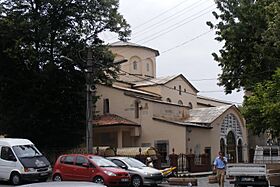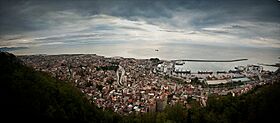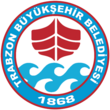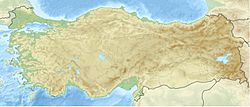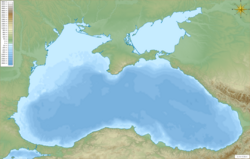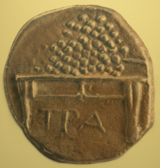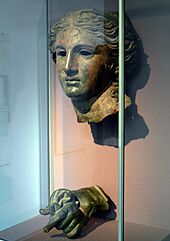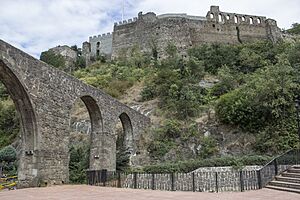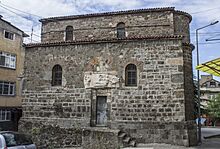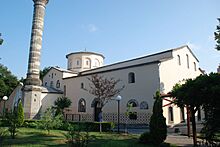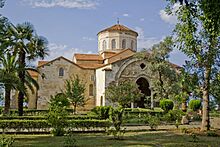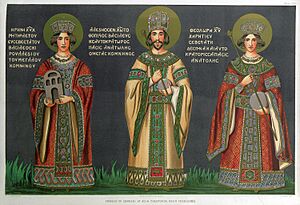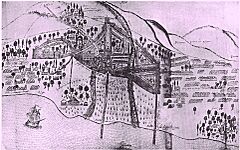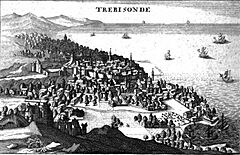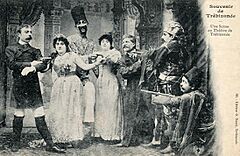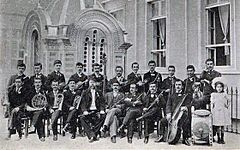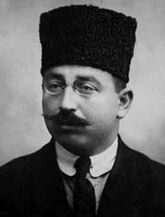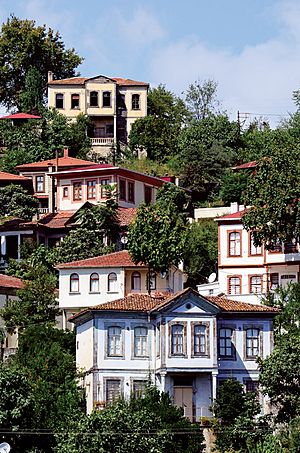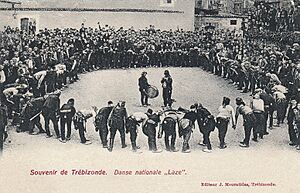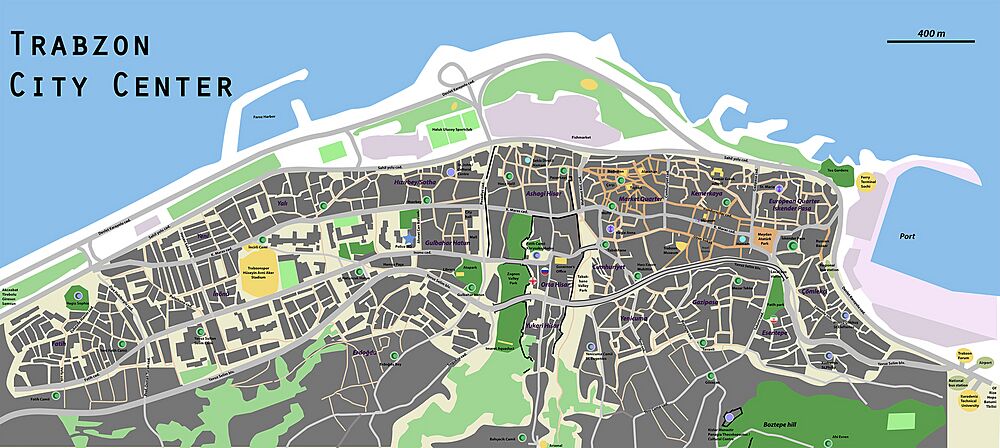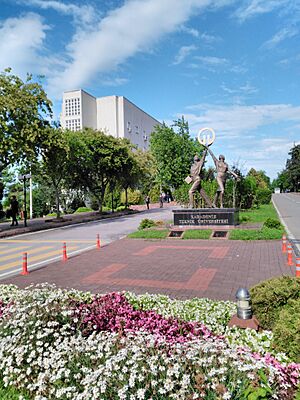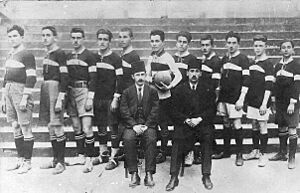Trabzon facts for kids
Quick facts for kids
Trabzon
|
||
|---|---|---|
|
City
|
||
|
Clockwise from top: Fatih Mosque; Lake Uzungöl; Atatürk Square; a general view of the city centre from Boztepe; Hagia Sophia of Trabzon; and Atatürk's House
|
||
|
||
| Nickname(s):
City of Tale in the East
|
||
| Country | Turkey | |
| Region | Black Sea Region | |
| Province | Trabzon | |
| Established | c. 756 BC | |
| Elevation | 0 m (0 ft) | |
| Population
(2022)
|
||
| • Urban | 293,661 | |
| Demonym(s) | Trapezian, Trapezuntine, Trebizonian, Trabzonlu, Trabzonite | |
| Time zone | UTC+3 (TRT) | |
| Postal code |
61xxx
|
|
| Area code(s) | (+90) 462 | |
| Licence plate | 61 | |
| Climate | Cfa | |
| Website | ||
Trabzon, also known as Trebizond, is a city on the Black Sea coast in northeastern Turkey. It is the capital of Trabzon Province. For centuries, Trabzon was an important stop on the historic Silk Road. This made it a place where many different religions, languages, and cultures mixed. It was also a key trading point for goods going to Persia and the Caucasus region.
Merchants from Venice and Genoa visited Trabzon during the Middle Ages. They traded items like silk, linen, and woolen fabrics. Both Venice and Genoa had special areas in the city for their merchants. These areas were important for Trabzon's trade, much like Galata was for Constantinople (now Istanbul). Trabzon was the capital of the Empire of Trebizond from 1204 to 1461. Later, its port became very important again for trade with Persia and the Caucasus.
Contents
- Understanding the City's Name
- Exploring Trabzon's Past
- Trabzon's Geography
- Trabzon's Economy
- People and Culture of Trabzon
- Main Places to See in Trabzon
- Education in Trabzon
- Trabzon's Food Culture
- Sports in Trabzon
- Mayors of Trabzon Metropolitan Municipality
- Famous People from Trabzon
- Trabzon's International Connections
- Images for kids
- See also
Understanding the City's Name
The Turkish name for the city is Trabzon. In English, it was historically called Trebizond. The city's first recorded name was the Greek word Trapezous. This name came from the Greek word trapeza, which means "table." It referred to the table-like hill where the city was first built. You can even see a table on an old coin from Trapezous!
In Latin, the city was called Trapezus. In Pontic Greek and Modern Greek, it is called Trapezounta. The city has also been known by other names in different languages, including Ottoman Turkish, Persian, Laz, Georgian, and Armenian. Over time, Western explorers and writers used many different spellings for the city's name.
Exploring Trabzon's Past
Ancient Times and Early History
Before the Greeks founded Trabzon, the area was home to tribes like the Colchians and Chaldian. The Hayasa people, who fought the Hittites in the 14th century BC, are thought to have lived south of Trabzon. Later, Greek writers mentioned the Macrones and Chalybes as local groups. The Laz were another important group in the east, part of the Colchis kingdom.
The city of Trabzon was founded in classical antiquity around 756 BC. It was started by traders from Sinope, a Greek city. Trabzon was one of about ten Greek trading posts along the Black Sea coast. Like most Greek colonies, it was a small Greek settlement, not a large empire. At first, Trapezous paid tribute to Sinope. Old coins suggest that banking activities happened here as early as the 4th century BC.
Cyrus the Great later added the city to the Achaemenid Empire. He might have been the first ruler to bring the eastern Black Sea region under one government. Trabzon traded with groups like the Mossynoeci. When Xenophon and his Ten Thousand Greek soldiers were leaving Persia, Trebizond was the first Greek city they reached.
The city remained under Persian rule until Alexander the Great's conquests. After his wars, the cities in the Pontus region gained independence. Local rulers still claimed some Persian heritage, and Persian culture influenced the city. For example, holy springs near the city were dedicated to the Persian-Anatolian god Mithra. In the 2nd century BC, Pharnaces I added Trabzon to the Kingdom of Pontus. Mithridates VI Eupator made it a main port for his fleet.
After Mithridates was defeated in 66 BC, Trabzon became part of the new client Kingdom of Pontus. When the kingdom joined the Roman Empire later, Trabzon's fleet became the Classis Pontica. The city gained special status, allowing it to make its own laws and coins. Trabzon became important because it had roads leading to the Armenian border and the Euphrates valley. New roads were built under Emperor Vespasian. Emperor Hadrian visited in 129 AD and ordered improvements to the harbor.
In 257 AD, the Goths attacked and looted Trabzon. The city was rebuilt but then attacked again by the Persians in 258 AD. It took a long time for Trabzon to recover. Christianity arrived in Trabzon by the 3rd century. Eugenius, who destroyed a statue of Mithras, became the city's patron saint. Early Christians found safety in the Pontic Mountains, where they built Vazelon Monastery in 270 AD and Sumela Monastery in 386 AD. Trabzon had its own bishop early on.
Byzantine Rule and Trade
During the time of Emperor Justinian, Trabzon was a key base in his wars against Persia. An inscription on the city's eastern gate shows that Justinian rebuilt the city walls after an earthquake. Before the 7th century, the city's university was reopened, teaching subjects like math and music. Students came from all over the Byzantine Empire and even Armenia.
Trabzon became more important when it became the center of the Chaldia region. Its trade routes also became busy again between the 8th and 10th centuries. Muslim traders often visited Trabzon to buy Byzantine silk and send it to eastern countries. Italian trading cities like Venice and Genoa used Trabzon as a major port. They traded goods between Europe and Asia, especially along the Silk Road. This trade brought a lot of money to the city through taxes. The Greeks built many forts to protect these trade routes.
After the Byzantine defeat at the Battle of Manzikert in 1071, Trabzon briefly came under Seljuk rule. But a local leader, Theodore Gabras, took control of the city from the Turks. He ruled Trabzon like his own kingdom. Even after he died in 1098, his family continued to rule independently for many years.
The Empire of Trebizond
The Empire of Trebizond was formed after a Georgian expedition in 1204. This happened just before Constantinople was attacked during the Fourth Crusade. Located in the far northeastern part of Anatolia, it was the longest-lasting of the states that followed the Byzantine Empire. Some writers saw it as a small border state, not a true empire.
Geographically, the Empire of Trebizond was a narrow strip along the southern Black Sea coast. It did not extend far inland beyond the Pontic Mountains. However, the city became very rich from taxes on trade between Persia and Europe. The Mongol siege of Baghdad in 1258 sent even more trade caravans to Trabzon. Genoese and Venetian traders regularly visited the city.
To secure their trade, the Genoese bought a fort called "Leonkastron" in 1306. The Venetians also built a trading post nearby. Many other European traders settled between these two Italian areas, creating the "European Quarter." Italians continued to live in the city until the early 1900s. Marco Polo was one famous person who visited Trabzon during this time. He ended his overland journey there and sailed to Venice.
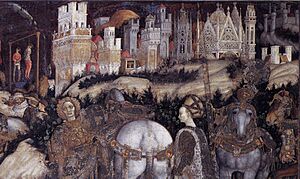
Italian traders brought stories about Trabzon back to Western Europe. The city played a mythical role in European literature. Writers like Miguel de Cervantes and François Rabelais mentioned it in their books. The city's history also inspired paintings, plays, and operas.
Trabzon also played a role in the early Renaissance. When Constantinople was taken by Western forces, many Byzantine thinkers found refuge in Trabzon. Emperors Alexios II of Trebizond and Alexios III supported arts and sciences. After a big fire in 1310, the university was rebuilt. Gregory Choniades opened a new astronomy academy there, which had one of the best observatories outside Persia. Choniades brought and translated important works from Tabriz, which later reached Western Europe.
The observatory was known for its accurate predictions of solar eclipses. Scientists in Trabzon were among the first to compare new ideas with old Greek texts. Basilios Bessarion and George of Trebizond traveled to Italy. They taught about Plato and Aristotle, starting important debates. Bessarion was even considered for the position of Pope.
The Black Death arrived in Trabzon in September 1347, likely from Kaffa. At that time, the local nobles were fighting in the Trapezuntine Civil War. In 1340, Tur Ali Beg, an ancestor of the Aq Qoyunlu, attacked Trabzon. He besieged the city in 1348 but failed. Later, Alexios III of Trebizond made peace by marrying his sister to Kutlu Beg, Tur Ali Beg's son.
Constantinople remained the Byzantine capital until the Ottoman Sultan Mehmed II conquered it in 1453. He then conquered Trebizond eight years later, in 1461.
After the Ottoman conquest, many Greek Orthodox people, called Pontic Greeks, continued to live in the area. They stayed until 1923, when they moved to Greece. A few thousand Greek Muslims still live in the area today. Many of Trabzon's Greek Byzantine buildings still stand.
{{wide image|Cassone Conquest of Trebizond Apollonio di Giovanni di Tomaso.png|900px|This painting, called 'Conquest of Trebizond,' was made by Apollonio di Giovanni di Tomaso after the city fell. It shows Trabzon as important as Constantinople (on the far left). The city was legendary in Western European literature and thought for centuries.]]
Trabzon During the Ottoman Empire
The last Emperor of Trebizond, David, surrendered the city to Sultan Mehmed II in 1461. After this, Mehmed II sent many Turkish settlers to the area. However, the old Greek, Laz, and Armenian communities remained. In 1523, about 85% of the city's population was Christian, and 15% was Muslim. Most Christians were Greeks, with a smaller Armenian community. By the late 17th century, many local Christians, especially outside the city, had converted to Islam.
Between 1461 and 1598, Trabzon was an important administrative center. In 1598, it became the capital of its own province, the Trebizond Eyalet. Later, it became the Trebizond Vilayet. During Sultan Bayezid II's rule, his son Prince Selim (who later became Sultan Selim I) was the governor of Trabzon. Selim I's son, Suleiman the Magnificent, was born in Trabzon in 1494. Ottoman leaders often appointed local Chepni Turks and Laz leaders as governors.
Trabzon had many wealthy merchants in the late Ottoman period. The Christian minority had a big impact on the city's culture, economy, and politics. Many European countries opened consulates in Trabzon because it was so important for trade. In the early 1800s, Trabzon was the main port for Persian exports. The opening of the Suez Canal later reduced the city's international trade, but the region's economy still grew.
In the late 1800s, many families, especially Christians, moved from Trabzon to Crimea and southern Ukraine. They looked for farmland or jobs in new cities. Among these migrants were the grandparents of Bob Dylan. Many families also moved to Constantinople (Istanbul) to start businesses. These migrants continued to influence cities around the Black Sea. At the same time, thousands of Muslim refugees from the Caucasus arrived in Trabzon after 1864.
Trabzon was one of the first cities in the Ottoman Empire to get Western cultural and technological innovations. In 1835, American missionaries opened a station there. Hundreds of schools were built in the province in the early 1800s, giving the region high literacy rates. Greek, Muslim, and Armenian communities all set up schools. International schools were also opened. The city got a post office in 1845. New churches and mosques were built, along with the first theater, printing houses, photo studios, and banks. The oldest photos of the city center, from the 1860s, show camel trains from Persia.
Between one and two thousand Armenians were killed in Trabzon during the Hamidian massacres of 1895. This had a big impact on the Armenian community. Many important Armenian residents, like scholars and artists, moved to the Russian Empire or France. The large Greek population in the city was not affected. News from Trabzon was reported in many European newspapers, which were also popular among city residents.
Ottoman era paintings and drawings of Trebizond
-
Trebizond from the sea by Ivan Aivazovsky
Trabzon in Modern Times
In 1901, the harbor was equipped with cranes. In 1912, the Sümer Opera House opened in the central Meydan square. The start of First World War ended the city's peaceful and rich period. Many young men from Trabzon died at the Battle of Sarikamish. The Russian navy also bombed the city five times, killing 1300 people.
In July 1915, most Armenian men from the city were forced to march south. They were sent to the mines of Gümüşhane and were never seen again. Other Armenian victims were reportedly taken to sea in boats that were then overturned. In some areas of Trabzon province, local Muslim people tried to protect the Christian Armenians.
The coast between Trabzon and the Russian border saw major battles during the Trebizond Campaign of World War I. The Russian army landed east of Rize on March 4, 1916. The Lazistan region fell quickly. However, strong resistance around Of and Çaykara slowed the Russian advance. The Ottoman government in Trabzon, expecting the city to fall, handed control to the Greek metropolitan bishop, Chrysantos Philippidis.
Chrysantos promised to protect the Muslim population. Ottoman forces left Trabzon, and on April 15, the city was taken by the Russian Caucasus Army without a fight. There was also a massacre of Armenians and Greeks in Trabzon just before the Russians arrived. Many Turkish men left the city fearing revenge. However, many Turks who had fled began to return during the Russian occupation. Governor Chrysantos helped them rebuild their schools, despite Russian disapproval.
In early 1917, Chrysantos tried to arrange peace between Russia and the Ottomans, but it failed. During the Russian Revolution of 1917, Russian soldiers in Trabzon rioted and looted. Governor Chrysantos calmed them down, and the Russian Army eventually left the city and eastern Anatolia. In March and April 1918, Trabzon hosted the Trebizond Peace Conference. Here, the Ottomans agreed to give up their military gains in the Caucasus.
In December 1918, Trabzon's deputy governor, Hafız Mehmet, blamed the former governor, Cemal Azmi, for the Armenian Genocide in the city in 1915. War crimes trials were held in Trabzon in early 1919. Cemal Azmi was sentenced to death in his absence.
During the Turkish War of Independence, some Christian Pontic Greek communities in Trabzon province rebelled. However, when Greek nationalists came to Trabzon to start a revolution, the local Greek population did not support them. At the same time, the Muslim people of the city protested the arrest of prominent Christians, remembering Chrysantos's protection.
Trabzon's leaders opposed the election of Mustafa Kemal as the leader of the Turkish revolution. The governor and mayor were against violence towards Ottoman Greek people. The government of Trabzon refused to give weapons to Mustafa Kemal's associate, Topal Osman, who was responsible for mass killings in the western Pontus region. Osman was forced out of the city by armed Turkish port-workers.
Governor Chrysantos went to the Paris Peace Conference. He suggested creating a Republic of Pontus to protect different ethnic groups. For this, he was sentenced to death by the Turkish Nationalist forces and could not return to Trabzon. After the war, the Treaty of Sèvres was replaced by the Treaty of Lausanne (1923). Trabzon became part of the new Turkish Republic.
The efforts of Trabzon's pro-Ottoman, anti-nationalist people only delayed what was coming. The governments of Turkey and Greece agreed to a forced population exchange. This meant over 100,000 Greeks from Trabzon and nearby areas moved to Greece.
During the war, Trabzon politician Ali Şükrü Bey was a leader of the first Turkish opposition party. In his newspaper, he criticized the Kemalist government, including the violence against Greeks during the population exchange. He argued that recognizing different ethnic groups was not a threat to the Turkish nation.
A political and cultural difference between the Eastern Black Sea Region and the rest of Anatolia continued throughout the 20th century. It still affects Turkish politics today. Even now, politicians from Trabzon sometimes face unfair attacks.
During World War II, shipping was limited because the Black Sea was a war zone. Important exports like tobacco and hazelnuts could not be sold, and living standards dropped.
As Turkey developed, Trabzon's economy and trade grew. The coastal highway and a new harbor improved trade with central Anatolia, leading to some growth. However, progress has been slower compared to western and southwestern Turkey.
Trabzon is famous in Turkey for its anchovies called hamsi. These are a main dish in many city restaurants. Major exports from Trabzon include hazelnuts and tea.
The city still has a community of Greek-speaking Muslims. Most are from nearby areas like Tonya, Sürmene, and Çaykara. However, the local Pontic Greek language, called "Romeika", is mostly spoken by older generations.
Trabzon's Geography
Trabzon Province covers about 4,685 square kilometers. It borders the provinces of Rize, Giresun, and Gümüşhane. About 22.4% of the area is flat plateau, and 77.6% is hills. The Pontic Mountains run through Trabzon Province.
Trabzon used to be an important landmark for sailors in the Black Sea during bad weather. The Italian saying "perdere la Trebisonda" (losing Trebizond) is still used today. It means losing your sense of direction. Italian trading cities like Venice and Genoa were active in Black Sea trade for centuries.
Trabzon has four lakes: Uzungöl, Çakırgöl, Sera, and Haldizen Lakes. There are several streams, but no large rivers.
Trabzon's Climate
Trabzon has a climate typical of the eastern Black Sea region. It has a humid subtropical climate near the coast. This means it has hot, humid summers and mild winters. A small part of the province is subtropical. However, slightly higher areas near the coast have an oceanic climate. The mountainous areas are humid continental or subarctic. Tundra can be found on the peaks of the Pontic Alps.
Summers are warm, with average high temperatures around 28°C in August. Winters are generally cool, with the lowest average low temperature around 5°C in February. It rains most in autumn and winter, but less in summer. Snowfall is common between December and March, usually for one or two weeks, and can be heavy.
The water temperature in the Black Sea near Trabzon is generally mild. It ranges from 8°C to 20°C throughout the year.
| Climate data for Trabzon (1991–2020, extremes 1927–2020) | |||||||||||||
|---|---|---|---|---|---|---|---|---|---|---|---|---|---|
| Month | Jan | Feb | Mar | Apr | May | Jun | Jul | Aug | Sep | Oct | Nov | Dec | Year |
| Record high °C (°F) | 25.9 (78.6) |
30.1 (86.2) |
35.2 (95.4) |
37.6 (99.7) |
38.2 (100.8) |
36.7 (98.1) |
37.0 (98.6) |
38.2 (100.8) |
37.9 (100.2) |
33.8 (92.8) |
32.8 (91.0) |
26.4 (79.5) |
38.2 (100.8) |
| Mean daily maximum °C (°F) | 11.3 (52.3) |
11.4 (52.5) |
13.0 (55.4) |
16.3 (61.3) |
20.0 (68.0) |
24.5 (76.1) |
27.5 (81.5) |
28.1 (82.6) |
25.1 (77.2) |
21.0 (69.8) |
16.5 (61.7) |
13.1 (55.6) |
19.0 (66.2) |
| Daily mean °C (°F) | 7.7 (45.9) |
7.5 (45.5) |
9.2 (48.6) |
12.2 (54.0) |
16.4 (61.5) |
20.9 (69.6) |
23.8 (74.8) |
24.4 (75.9) |
21.1 (70.0) |
17.2 (63.0) |
12.7 (54.9) |
9.5 (49.1) |
15.2 (59.4) |
| Mean daily minimum °C (°F) | 5.0 (41.0) |
4.6 (40.3) |
6.2 (43.2) |
9.0 (48.2) |
13.4 (56.1) |
17.6 (63.7) |
20.6 (69.1) |
21.2 (70.2) |
17.8 (64.0) |
14.1 (57.4) |
9.6 (49.3) |
6.8 (44.2) |
12.2 (54.0) |
| Record low °C (°F) | −7.0 (19.4) |
−7.4 (18.7) |
−5.8 (21.6) |
−2.0 (28.4) |
4.2 (39.6) |
9.2 (48.6) |
11.0 (51.8) |
13.5 (56.3) |
7.3 (45.1) |
3.4 (38.1) |
−1.6 (29.1) |
−3.3 (26.1) |
−7.4 (18.7) |
| Average precipitation mm (inches) | 88.8 (3.50) |
63.1 (2.48) |
69.3 (2.73) |
62.8 (2.47) |
55.5 (2.19) |
52.3 (2.06) |
34.7 (1.37) |
59.4 (2.34) |
85.4 (3.36) |
134.1 (5.28) |
103.2 (4.06) |
93.5 (3.68) |
902.1 (35.52) |
| Average precipitation days | 10.82 | 9.68 | 11.09 | 11.32 | 11.00 | 9.95 | 7.32 | 9.32 | 9.64 | 11.27 | 9.27 | 10.64 | 121.3 |
| Average relative humidity (%) | 69 | 69 | 73 | 75 | 77 | 75 | 73 | 73 | 74 | 73 | 70 | 68 | 72 |
| Mean monthly sunshine hours | 71.3 | 84.8 | 99.2 | 135.0 | 170.5 | 192.0 | 176.7 | 151.9 | 147.0 | 127.1 | 105.0 | 65.1 | 1,525.6 |
| Mean daily sunshine hours | 2.3 | 3.0 | 3.2 | 4.5 | 5.5 | 6.4 | 5.7 | 4.9 | 4.9 | 4.1 | 3.5 | 2.1 | 4.2 |
| Source 1: Turkish State Meteorological Service | |||||||||||||
| Source 2: Weatherbase | |||||||||||||
Trabzon's Economy
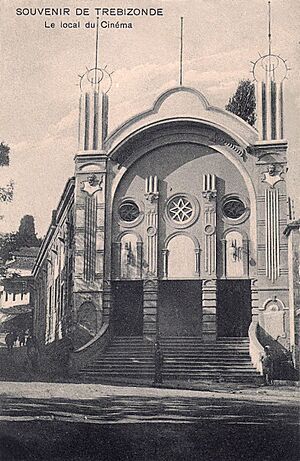
In 1920, Trabzon's port was considered the most important Turkish Black Sea port. It traded with places as far as Tabriz and Mosul. In 1911, an agreement was made to develop the harbor. When the Russians occupied Trabzon, they built a mole and an extended pier to make loading and unloading easier.
In 1920, Trabzon produced linen cloth, silver filagree, and did tanning. It also produced small amounts of cotton, silk, and wool. Tobacco and hazelnuts were exported. The tobacco from Trabzon was known for its large leaves and bright color. Trabzon also produced white green beans, which were sold in Europe. Poultry farming was also popular. Before 1914, sericulture (silk farming) was common. The area had copper, silver, zinc, iron, and manganese. Copper was used by local coppersmiths.
Trabzon Airport opened in 1957. Today, Trabzon's economy and trade have grown. The coastal highway and a new harbor have increased trade with central Anatolia. However, progress has been slower compared to western and southwestern Turkey.
People and Culture of Trabzon
Historical Communities
When Trabzon fell to the Ottomans in 1461, it was mostly a Christian and Greek city. Over time, the number of Greek Christians slowly decreased. At first, most Muslims were immigrants or local converts. But in the 16th century, more people converted to Islam as mosques and dervish lodges were built.
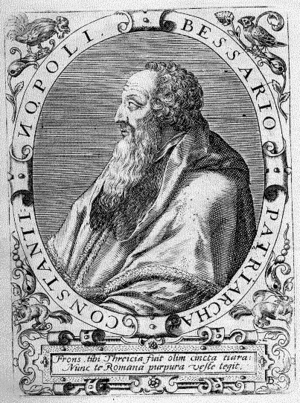
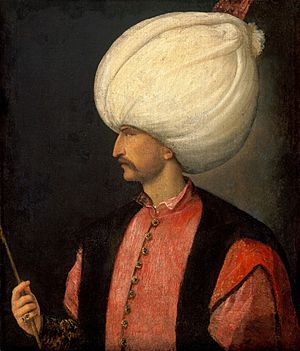
Laz people also live in Trabzon. Many Laz villages in and around Trabzon date back to the rule of Queen Tamar (1160–1213). During her rule, many Georgians moved to Trabzon and still speak their native language. An Armenian community existed in Trabzon as early as the 7th century.
In the 13th and 14th centuries, many Armenian families moved from Ani to Trabzon. A 15th-century diary noted that Armenians had a large enough population to have their own bishop. In the early 16th century, Armenians made up about 13% of the city's population. Today, Trabzon does not have an Armenian-speaking community.
The Chepni people, a tribe of Oghuz Turks, were important in the eastern Black Sea area in the 13th and 14th centuries. They live in the Şalpazarı region of Trabzon Province. There are few historical records of large Turkish-speaking groups in Trabzon before the late 15th century, except for the Chepnis. The original Greek and Armenian speakers influenced the Turkish spoken in the region.
It is possible that most people in Trabzon and Rize (other ancient Greek colonies) were local Caucasian tribes like the Colchians and the Laz. These groups had partly adopted Greek religion and language. Some researchers point out cultural similarities between the Eastern Black Sea coast and the Caucasus region.
City Growth and People
| Population | 2007 | 2008 | 2009 | 2010 | 2011 | 2012 | 2013 | 2014 | 2015 |
|---|---|---|---|---|---|---|---|---|---|
| Total | 740,569 | 748,982 | 765,127 | 763,714 | 757,353 | 757,898 | 758,237 | 766,782 | 768,417 |
| Urban | 396,646 | 390,797 | 408,103 | 415,652 | 757,353 | 757,898 | 758,237 | 766,782 | 768,417 |
Trabzon's Culture and Traditions
Folk dancing is still very popular in the Black Sea Region. The "Horon" is a famous dance unique to Trabzon and its surrounding area. Men, women, young, and old all perform it at festivals, weddings, and harvest times. It is lively, similar to Russian Cossack dances. The Trabzon folk dance is likely from the eastern Black Sea region, which has a wide variety of folk music.
People from Trabzon are known for being religious and patriotic. Many Trabzonites are very loyal to their family, friends, religion, and country. Atatürk chose his presidential guards from Trabzon and nearby Giresun because of their strong fighting skills and loyalty.
Outside the city, and even in some parts of it, rural traditions from Black Sea village life are still strong. These include traditional gender roles, social conservatism, and hospitality. People are often willing to help strangers. All parts of an farming lifestyle, both good and bad, are present, such as hard work, strong family ties, and a close connection to nature.
People from the eastern Black Sea region are also known for their quick wit and sense of humor. Many jokes in Turkey are told about people from the Black Sea region, called Karadeniz fıkraları (Black Sea jokes). The character Temel, a common funny figure in many cultures, is an important part of Turkish oral tradition.
The city's fame in the English-speaking world grew with Dame Rose Macaulay's novel, The Towers of Trebizond (1956).
Main Places to See in Trabzon
Trabzon has many interesting places to visit. Some date back to the ancient empires that once ruled the region. In the city center, you can find many shops, stalls, and restaurants around the Meydan, a central square with a tea garden.
- The Hagia Sophia (now a mosque), is a beautiful Byzantine church. It is probably the city's most important tourist attraction.
- Trabzon Castle ruins can be seen in the city, but you cannot visit them because they are in a military area.
- The "Atatürk Köşkü" is a villa built in 1890 by a local Greek merchant. Mustafa Kemal Atatürk stayed here in 1924 and 1937. It is now a museum showing rooms from that period and honors the founder of the Turkish Republic.
- Boztepe Park is a small park and tea garden on the hills above Trabzon. It offers a panoramic view of almost the entire city.
- Uzun Sokak is one of Trabzon's busiest streets, great for shopping.
- Trabzon Museum is in the city center. It has interesting exhibits on the region's history, including many Byzantine artifacts.
- Trabzon's Bazaar District offers unique shopping on old, narrow streets.
- Saint Anne Church, Trabzon, in the city center, is one of the oldest churches in Trabzon.
- Kostaki Mansion is located north of Zeytinlik, near Uzun Sokak.
- Uzungöl Dursun Ali İnan Museum is an ethnographic museum in Uzungol that shares the history of Trabzon and the region.
Other important sites in the city include: Fatih Mosque (originally Panagia Khrysokephalos Church), Yeni Cuma Mosque (originally Agios Eugenios Church), Nakip Mosque (originally Agios Andreas Church), Hüsnü Köktuğ Mosque (originally Agios Elevtherios Church), İskender Pasha Mosque, Semerciler Mosque, Çarşı Mosque, Gülbahar Hatun Mosque and Türbe (built by Sultan Selim I), and Kalepark (originally Leonkastron).
In Trabzon Province, the main attractions are the Sümela Monastery and the Uzungöl lake. The monastery is built on the side of a very steep mountain about 50 km south of the city. Uzungöl is famous for its beautiful natural scenery. Other interesting places in the wider region include:
- Kaymaklı Monastery, an old Armenian Monastery;
- Kızlar Monastery of Panagia Theoskepastos;
- Kuştul Monastery of Gregorios Peristereotas;
- Vazelon Monastery of Agios Savvas;
- Cave churches like Agia Anna, Sotha, Agios Theodoros, Agios Konstantinos, Agios Christophoros, Agia Kyriakí, Agios Michail, and Panagia Tzita.
Education in Trabzon
Karadeniz Technical University in Trabzon welcomes students from all over Turkey, especially from the Black Sea and East Anatolian regions. It also has students from Turkic countries in Central Asia.
Historically, Trabzon was a center for Greek culture and education. From 1683 to 1921, a teachers' college called Phrontisterion of Trapezous operated there. This school greatly helped Greek education grow throughout the region. The building of this institution, built in 1902, is still the most impressive Pontic Greek monument in the city. Today, it houses the Turkish school Anadolu Lisesi.
Trabzon's Food Culture
Trabzon's local food often uses fish, especially hamsi (fresh European Anchovy). Trabzon produces 20% of all fish in Turkey. Local dishes include the Akçaabat köfte (spicy lamb meatballs from Akçaabat), Karadeniz pidesi (canoe-shaped pita bread, often with ground beef, cheese, and eggs), and kuymak (a Turkish fondue made with cornmeal, butter, and cheese).
Other local foods are Vakfıkebir ekmeği (large country-style bread), Tonya tereyağı (Tonya butter), tava mısır ekmeği (deep-dish corn bread), and kara lahana çorbası (bean and cabbage soup). Taflan kavurması is a cherry laurel dish served with onions and olive oil. Trabzon is also famous for its hazelnuts. The Black Sea region of Turkey is the world's largest producer of cherry and hazelnut, and a big area for tea. All these play an important role in the local food.
Sports in Trabzon
Football is the most popular sport in Trabzon. The city's main sports club, Trabzonspor, was the only Turkish football club outside Istanbul to win the Süper Lig (six times) until 2010. Before Trabzonspor's first championship in 1975–76, only the "Big Three" Istanbul clubs had won it. Because of Trabzonspor's success, the term "Big Three" changed to "Big Four."
Trabzonspor is also one of the most successful Turkish clubs in European Cups. They have beaten famous teams like Barcelona, Inter, Liverpool, Aston Villa, and Olympique Lyonnais. Famous former players include Şenol Güneş, Lars Olsen, and Shota Arveladze. In the 2021–2022 season, Trabzonspor won the championship early, ending a 38-year wait. Hundreds of thousands of Trabzon fans came to the city to celebrate.
Trabzon hosted the first Black Sea Games in July 2007 and the 2011 European Youth Summer Olympic Festival.
Mayors of Trabzon Metropolitan Municipality
- 1984-1989 Orhan Karakullukçu Anavatan Partisi
- 1989-1994 Atay Aktuğ SHP, CHP
- 1994-2002 Asım Aykan Refah Party, Fazilet Partisi, AK Party
- 2002-2004 Niyazi Sürmen AK Party
- 2004-2009 Volkan Canalioğlu CHP
- 2009-2019 Orhan Fevzi Gümrükçüoğlu AK Party
- 2019-2024 Murat Zorluoğlu AK Party
- 2024-present Ahmet Metin Genç AK Party
Famous People from Trabzon
Trabzon's International Connections
Twin Towns and Sister Cities
Trabzon is connected with these cities around the world:
Images for kids
-
The head and hand of a bronze statue from the 2nd century BC. It might be Anahit as Aphrodite. It was found south of Trabzon and is now in the British Museum.
See also
 In Spanish: Trebisonda para niños
In Spanish: Trebisonda para niños


